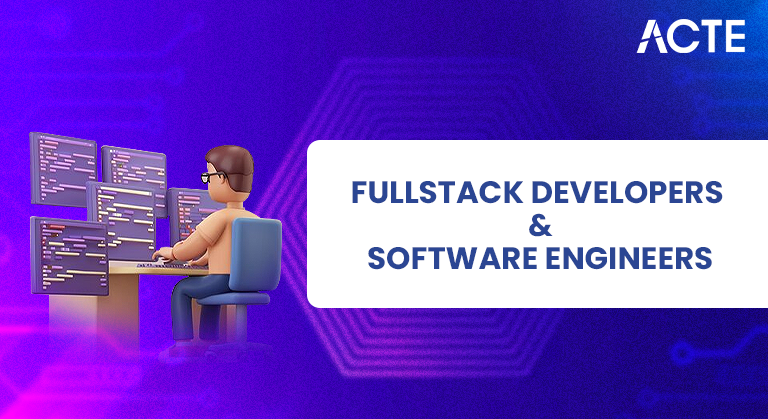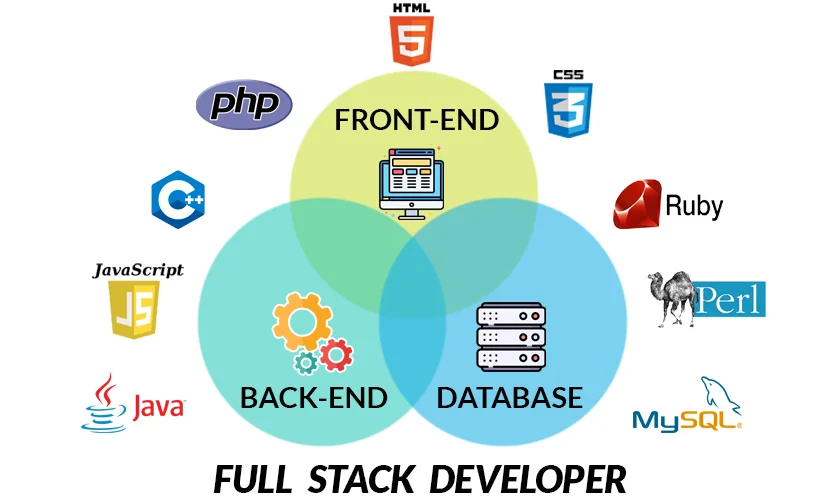
- Role Definitions
- Skill Set Comparison
- Frontend vs Backend vs Full Stack
- Tools and Technologies Used
- Career Scope and Salary
- Type of Projects Handled
- Learning Curve
- Freelancing vs Employment
- Conclusion
Role Definitions
A Full Stack Developer is a professional who is capable of working on both the front-end and back-end parts of web applications. They manage the client-side (what users interact with) and server-side (where data is processed and stored) components, making them versatile in software development projects. On the other hand, a Software Engineer is a broader role that encompasses the design, development, testing, and maintenance of software systems. Software Engineers can specialize in various fields Full Stack Training, including embedded systems, web development, mobile applications, and more. A Full Stack Developer is responsible for designing, developing, and managing both the frontend (client side) and backend (server side) of web applications. They work with a variety of technologies, including databases, servers, APIs, and user interfaces, ensuring seamless integration and functionality across the entire software stack. Software Engineer A Software Engineer focuses on designing, developing, testing, and maintaining software systems or applications. Their work may specialize in frontend, backend, or other domains such as embedded systems, algorithms, or infrastructure. Software Engineers apply engineering principles to solve complex problems and build scalable, reliable software.
Interested in Obtaining Your Full stack Certificate? View The Full Stack Developer Course Offered By ACTE Right Now!
Skill Set Comparison
Full Stack Developer Skills:
- Proficient in frontend technologies (HTML, CSS, JavaScript, frameworks like React or Angular).
- Backend development skills (Node.js, Java, Python, databases).
- Knowledge of RESTful APIs and server management.
- Understanding of version control (Git) and deployment Data Structures & Algorithms.
- Ability to handle both client-side and server-side development.
- Strong foundation in algorithms, data structures, and software design principles.
- Expertise in one or more programming languages (C++, Java, Python, etc.).
- Experience with system architecture, testing, and debugging.
- Knowledge of software development lifecycle (SDLC).
- Ability to work on specialized areas like embedded systems, cloud computing, or security.

Software Engineer Skills:
Frontend vs Backend vs Full Stack
Frontend Developer
- Focuses on the client-side of applications — what users see and interact with.
- Paging in Operating Systems Works with technologies like HTML, CSS, JavaScript, and frameworks such as React, Angular, or Vue.js.
- Responsible for user interface design, responsiveness, and user experience.
- Handles the server-side logic, databases, and application functionality.
- Uses languages like Java, Python, Node.js, Ruby, and manages servers, APIs, and databases.
- Ensures data processing, security, and integration with frontend.
- Combines both frontend and backend skills.
- Builds complete web applications, managing everything from UI to server and database.
- Versatile in multiple technologies and can handle the entire development process.
Backend Developer
Full Stack Developer
Tools and Technologies Used
Frontend Tools:
- HTML, CSS, JavaScript
- Frameworks/Libraries: React, Angular, Vue.js
- UI/UX Design Tools: Figma, Adobe XD
- Programming Languages: Java, Python, Node.js, Ruby, C#
- Frameworks: Spring, Django, Express.js, IPO Cycle .NET
- Databases: MySQL, PostgreSQL, MongoDB, Redis
- Git, GitHub, GitLab, Bitbucket
- CI/CD Tools: Jenkins, Travis CI, CircleCI
- Containerization: Docker, Kubernetes
- Cloud Platforms: AWS, Azure, Google Cloud
- Testing Tools: JUnit, Selenium, Postman
- End-to-end web application development (frontend + backend)
- Building interactive user interfaces and APIs
- Small to medium-sized projects requiring rapid development
- Startups and agile teams where multitasking is essential Throw and Throws Java.
- Integration of third-party services and databases
- Large-scale software systems and enterprise applications
- Specialized projects like embedded systems, machine learning, or cloud infrastructure
- Development of algorithms and performance-critical software
- System architecture design and optimization
- Maintenance and enhancement of legacy systems
- Offers flexibility in work hours and project choices
- Income can be variable and depends on client acquisition
- Requires self-management, marketing, and invoicing skills
- Opportunity to work on diverse projects across industries
- Limited access to employee benefits like health insurance and retirement plans Remove Duplicate Elements
- Provides stable, predictable salary and benefits
- Structured work environment with defined roles and responsibilities
- Access to professional development and team collaboration
- Less flexibility in choosing projects or work schedule
- Opportunities for career growth within the organization
Backend Tools:
Version Control & Collaboration:
Other Technologies:
Gain Your Master’s Certification in Full Stack Developer by Enrolling in Our Full Stack Master Program Training Course Now!
Career Scope and Salary
Software architects must master system design and scalability concepts to build applications that can handle growth. This includes designing systems that support horizontal scaling, load balancing, distributed computing, and high availability. Architects often work on high-level components like message queues, databases, caching layers, and microservices orchestration. They are also expected to make decisions about data partitioning, consistency models, and eventual consistency to ensure Full Stack Training that systems remain efficient under increased loads. System design involves planning and structuring software components to meet functional and non-functional requirements. A well-designed system ensures reliability, maintainability, and performance. Scalability is a critical aspect, focusing on the system’s ability to handle increased load by efficiently utilizing resources. This can be achieved through techniques like load balancing, caching, database sharding, and horizontal scaling. Architects must design systems that can grow seamlessly without performance degradation. Understanding user demand, choosing appropriate architectures (e.g., microservices or monoliths), and anticipating future growth are essential for building scalable, robust software solutions.
Type of Projects Handled
Full Stack Developers:

Software Engineers:
Are You Preparing for Full Stack Jobs? Check Out ACTE’s Full stack Interview Questions and Answers to Boost Your Preparation!
Learning Curve
The learning curve for Full Stack Developers involves mastering both front-end and back-end development, which requires a broad understanding of various languages, frameworks, and databases. The advantage is that many full-stack skills are self-taught through online resources, bootcamps, Call a Function in Python or practical projects. For Software Engineers, the learning path often begins with a formal education in computer science or related fields. Mastery of theoretical concepts like algorithms, data structures, and systems design is crucial, and practical experience is equally important. Software Engineers typically follow a more academic route before gaining real-world coding experience.
Freelancing vs Employment
Freelancing:
Employment:
Conclusion
In today’s dynamic tech landscape, both Full Stack Developers and Software Engineers play vital roles in building innovative software solutions. Understanding their distinct skills, responsibilities, and career paths helps professionals make informed choices and align with industry demands. With strong market demand and diverse opportunities, continuous learning and adaptability are key to long-term success. Whether you choose freelancing or traditional employment, mastering Full Stack Training collaboration and staying updated with evolving technologies will ensure a rewarding career in software development. While Full Stack Developers offer versatility by managing both frontend and backend development, Software Engineers often specialize in deeper technical domains, applying engineering principles to complex problems. The growing demand for skilled professionals in these roles highlights abundant career opportunities across industries and geographies. Success in these fields requires continuous learning, effective collaboration, and adaptability to new tools and methodologies. Whether opting for freelancing or traditional employment, building a strong foundation in technical skills and soft skills will pave the way for a rewarding and sustainable career in software development.





